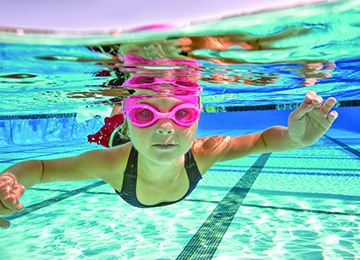by Corinne Joy Brown, Aquatics Instructor, YMCA Metropolitan Denver
 As an aquatics instructor at the YMCA of Metropolitan Denver, I can attest that no two classes are alike — which is partly what makes the aquatics curriculum so popular.
As an aquatics instructor at the YMCA of Metropolitan Denver, I can attest that no two classes are alike — which is partly what makes the aquatics curriculum so popular.
Ironically, I avoided the water most of my life — believing that swimming laps was boring. I can attest that, after five years of attending aquatics classes and now teaching, nothing is more fun than aquatics! Finding myself in love with water exercise at 70 is the blessing of my mature adult life.
For over 20 years I have made my living as a writer, and I recently began to see similarities between writing and teaching aquatics. Below are some lessons that transcend from writing to teaching:
Lesson One: Come As You Are
An author shows up as transparent as possible, bringing every experience we’ve ever had to that first blank page. I feel the same way when I stand in front of aquatics students. In our class, there’s no judgment. Each attendee is the sum of their own experiences, as is the instructor, all coming together in that great equalizer: the water. As in writing literature, the more I am myself in class, the more I seem to connect. Over time, I have begun to learn more about each student and their own stories as well; characters in a one-hour, life-changing aquatic challenge.
Lesson Two: Be Observant
A good writer notices things, picks up on details, and keeps a running file on the environment including facial expressions and atmosphere. A good aquatics teacher notices those things too, assessing by-the-minute if the participants are engaged, confused or distracted, and then acts on them.
Lesson Three: Structure
A good book has a beginning, middle, and end. So does a good aquatics class, from the cardio-enhancing warm-up through the cool down. It also depends on a consistent sense of structure, allowing enough time for each phase. Like a good story, you want to keep your audience wanting more and throw in some surprises. And like any satisfying ending, reaching a sense of joy by the end of every class.
Lesson Four:
Start With An Introduction
I make a point to introduce new people to the class and welcome them. Like a preface to a book, I use the beginning of class to set the stage for the day’s direction. These moments help create a sense of purpose, allow me to see who is in the water, and assess my workout strategy.
Lesson Five: Create A Sense Of
Community And Connection
A good writer and aquatics instructor targets their readers/swimmers and stays in touch in order to create a community. Students show up for more than just a workout. What’s good for the body is good for the soul, and each one of our YMCA aquatics classes offers a safe environment and a chance to be in the moment, feel connected, move, and experience a sense of release — not to mention the camaraderie that naturally ensues.
The Y plays a vital role in the community, serving as a safe, welcoming, and inclusive third place, a place beyond work and home.
I recently asked my class what they loved most about aquatics. The most recurring answer was “It just feels so good.” That sentence contains it all. In our classes, personal growth is evident and measurable in terms of increased strength and flexibility, as well as visible confidence and a sense of well-being. The YMCA Metropolitan Denver offers private, semi-private, and group swim lessons for individuals of all ages. Visit www.denverymca.org for more information.
